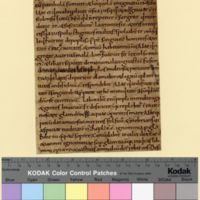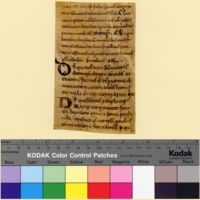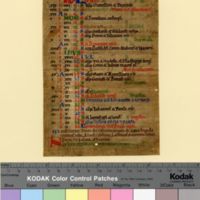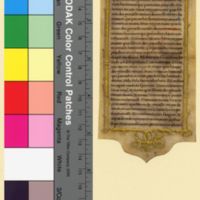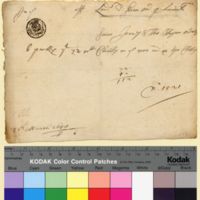Fragmenta Manuscripta
Historic, Stylistic, and Cultural Periods
The Fragmenta Manuscripta collection contains manuscript fragments dating from the eighth through seventeenth centuries. This encompasses the medieval (c. 500-c. 1400) and Early Modern (c. 1350-c. 1700) historic periods. The collection has a few strengths worth describing in more detail. The following categorizes the manuscripts based on historic, stylistic, and cultural periods. If you want to explore the collection further, you can search by location, century, and language in Digital Scriptorium.
Anglo-Saxon
The Anglo-Saxon period in Britain began after the collapse of the Roman Empire (late fifth century) until around the year 1100. The Angles and the Saxons were two Germanic groups that settled in Britain in the fifth and sixth centuries. In time, the groups formed a distinctive new culture. You might be familiar with the Anglo-Saxons because of the extraordinary archaeological discovery of a ship burial at Sutton Hoo. The excavation showed the Anglo-Saxons to be skilled metalworkers who lavished beautiful objects with multicolored glass and precious stones. Or perhaps you are familiar with the rich storytelling traditions of the Anglo-Saxons through the famous epic poem Beowulf. Fragmenta Manuscripta has four manuscript fragments that were produced in Britain or brought to Britain during this period. Significantly, our collection is one of only fourteen collections of Anglo-Saxon manuscripts in the United States.[1]
The four Anglo-Saxon manuscript leaves in the collection show the connections between England, Ireland, and the continent during the early middle ages. FM 002 is written in Insular script, which developed in Ireland and was brought to England and the continent by traveling monks. Typical of Insular script are large initial letters followed by a gradual diminution of letters in a word. The other three manuscripts are written in Caroline minuscule, a type of script developed by the Carolingians that featured uniform, small, rounded letter forms, clear capital and lowercase letters, and spaces between words on the manuscript page. This script gradually replaced the Insular script in Anglo-Saxon manuscripts, and is the basis of our writing today.[2]
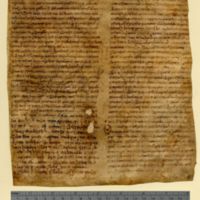
Identifier: Fragmenta Manuscripta 002
Date: 800-899
Contents: Beda Venerabilis, De orthographia
Language: Latin
Location: Wales (?)
Script: Insular
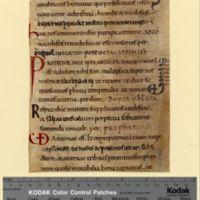
Identifier: Fragmenta Manuscripta 003
Date: 1000-1015
Contents: Sacramentary
Language: Latin
Location: England
Script: Caroline Minuscule
Anglo-Norman and the Romanesque and Gothic styles
William the Conqueror led the Normans from western France to England and placed himself on the throne in 1066. The Normans assimilated with the Anglo-Saxons living in England so much so that scholars speak of an Anglo-Norman culture living in England during the twelfth century. The Normans and Anglo-Normans in England accelerated the spread of the pan-European style known as the Romanesque—so named by antiquarians in the nineteenth century because the architecture took on the rounded arches and vaulted spaces typical of the Romans. In manuscript illumination, figures tended to look segmented, with the parts of the body easily identifiable from one another, and backgrounds were abstract blocks of colors in bold blues, greens, and reds. Scribes continued to use the Caroline minuscule developed by the Carolingians in the ninth century, and letters and decorations are picked out in earthy browns and greens. Many manuscripts in this period also show a transition to the new Gothic bookhand that became the dominant formal bookhand in Europe during the thirteenth through sixteenth centuries.
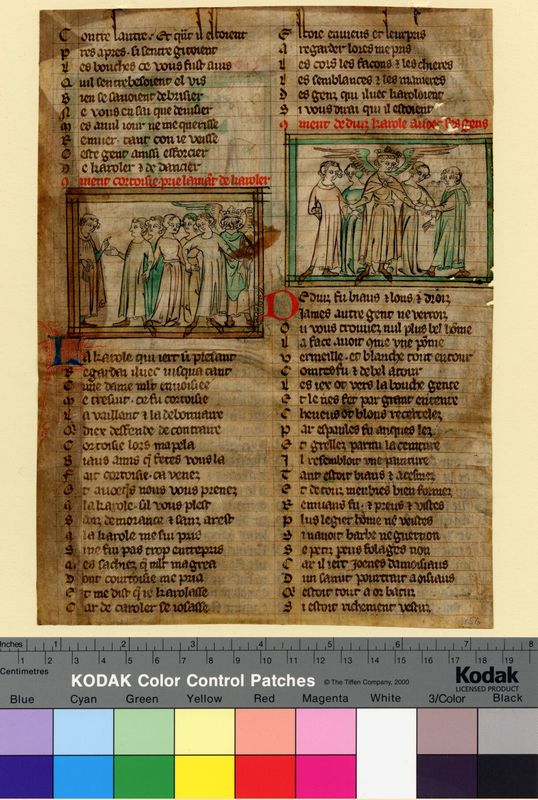
Identifier: Fragmenta Manuscripta 156
Date: 1300-1350
Contents: Jean de Meun and Guillaume de Lorris, Roman de la Rose
Language: French
Location: France
Script: Gothic
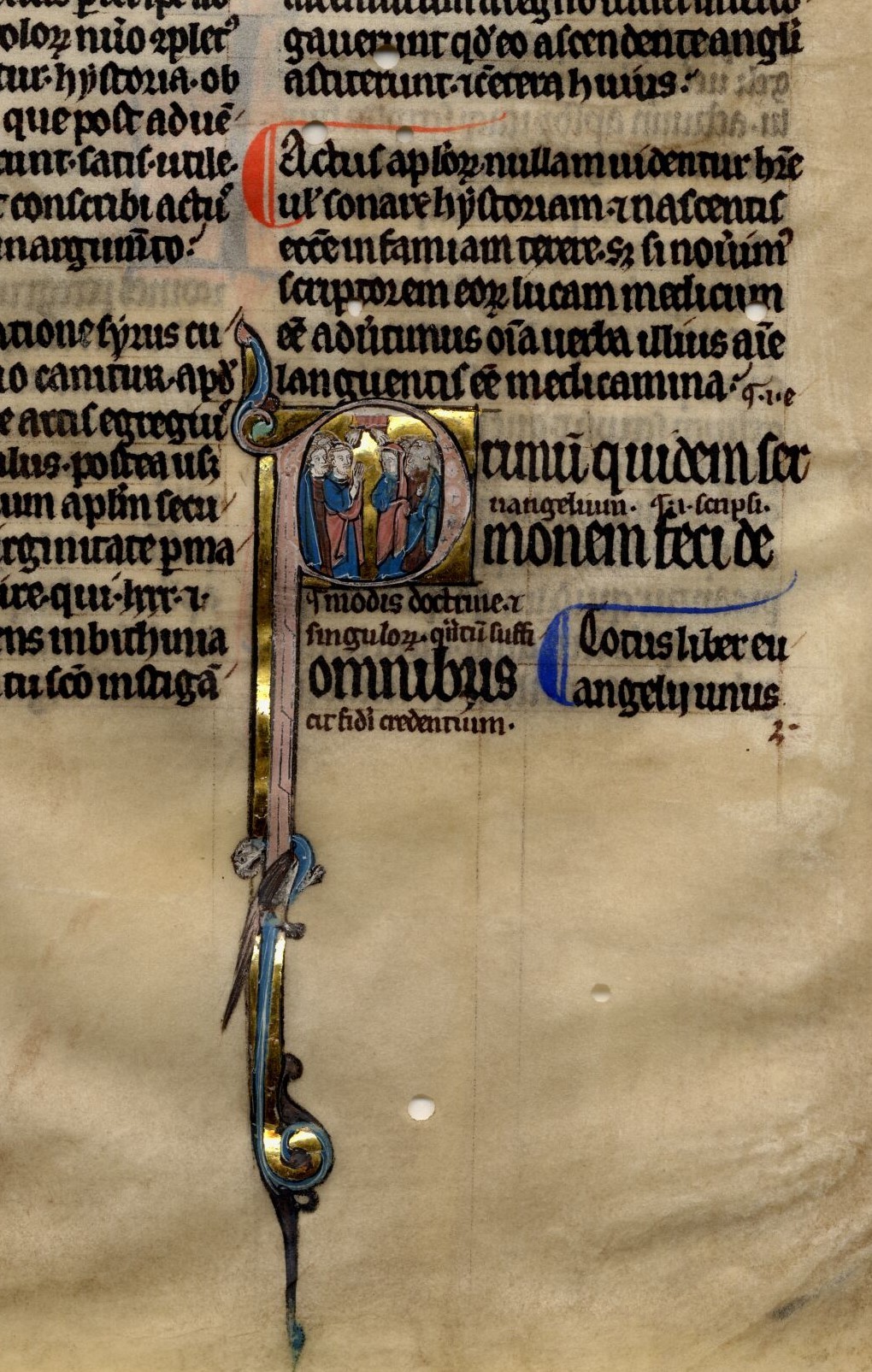
Identifier: Fragmenta Manuscripta 055
Date: 1250-1275
Contents: Bible, glossed
Language: Latin
Location: England
Script: Gothic
When Renaissance intellectuals looked back to the art of the period from about c. 1150-c. 1400 in the medieval west, they thought it looked barbaric and termed it Gothic after the names of the Germanic groups that moved throughout Europe during and after the fall of the Roman Empire. The term was never used by people living at that time, which is why some scholars avoid using it today. The architecture of this period was anything but barbaric. Cathedrals rose higher in the sky as stained-glass windows also increased in scale, letting more light into these vast spaces. In the figural arts, artists moved their attention to emphasize the human relationship to god. Figures became more naturalistic and solid, they swayed and moved in space as they twisted and interacted with one another. Regional styles vary their approach to Gothic art, but we tend to see a lot of short hair cuts that fall on either side of the face in tight curls following the popular court style of France that spread throughout northern Europe. We can see these types of figures in the illuminations of the Roman de la Rose (FM 156) and in the figures within the historiated initial watching the Ascension of Christ (FM 055). See manuscript decoration for more.
The script used in formal books is called blackletter, Gothic script, Gothic bookhand, Gothic minuscule, or Gothic textura. It developed from the Caroline minuscule with their small, uniform letters. Rather than the rounded forms of the Caroline minuscule, the Gothic script has tall, narrow letters-almost mimicking the pointed arches typical of Gothic cathedrals. The Gothic script is also squeezed together with letters blending into one another to fit as many words as possible onto each page. The letters are very black with pops of color in either red or blue. The Gothic script took on many different regional variations, which enables scholars to pinpoint approximate dates and regions where manuscripts were produced.
Other types of script existed. One type was a Gothic cursive script principally used in legal texts and documents that were prepared quickly. Sometimes known as a court hand, these scripts also had regional variations.
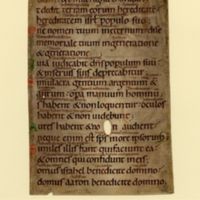
Identifier: Fragmenta Manuscripta 046
Date: 1050-1099
Contents: Psalter, glossed
Language: Latin
Location: England, Ramsey Abbey (?)
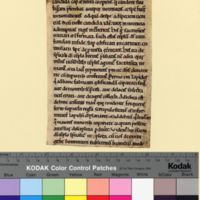
Identifier: Fragmenta Manuscripta 005
Date: 1140-1160
Contents: Ivo of Chartres, De ecclesiasticis sacramentis et officiis. Contains part of Sermon IV, "De sacramentis dedicationis."
Language: Latin
Location: England
Script: Transitional
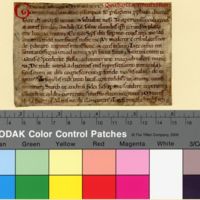
Identifier: Fragmenta Manuscripta 006
Date: 1100-1125
Contents: Isidore of Seville, De fide catholica ex veteri et novo testamento. Contains parts of Book I, chapters 16, 17 and the very beginning of 18
Language: Latin
Location: England
Script: Transitional
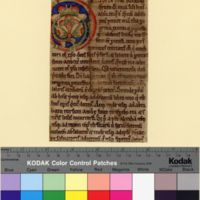
Identifier: Fragmenta Manuscripta 009
Date: 1150-1199
Contents: Augustine of Hippo, De civitate Dei. Contains part of xvii.23, 24, and xviii.1.
Language: Latin
Location: England
Script: Romanesque

Identifier: Fragmenta Manuscripta 011
Date: 1150-1199
Contents: Augustine of Hippo, Enarrationes in Psalmos. Contains part of the commentary on Ps. 74.
Language: Latin
Location: England
Script: Transitional
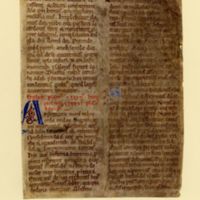
Identifier: Fragmenta Manuscripta 014
Date: 1100-1199
Contents: Cassiodorus, in psalterium expositio. Pertains to Pss. 135, 136
Language: Latin
Location: England, Bury St. Edmunds
Script: Caroline minuscule
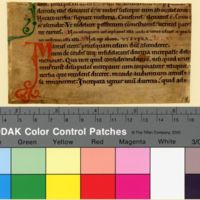
Identifier: Fragmenta Manuscripta 018
Date: 1140-1160
Contents: Breviary
Language: Latin
Location: England
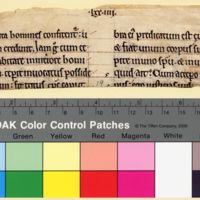
Identifier: Fragmenta Manuscripta 019
Date: 1150-1199
Contents: Augustine of Hippo, Enarrationes in Psalmos. Contains part of commentary on Ps. 74.
Language: Latin
Location: England
Identifier: Fragmenta Manuscripta 020
Date: 1100-1199
Contents: Psalter. Text is continuous from recto to verso, with Ps. 105, vv. 6-25, the page break occurring in v. 15.
Language: Latin
Location: England
Script: Transitional
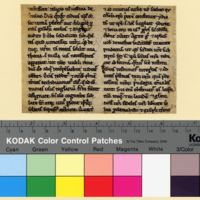
Identifier: Fragmenta Manuscripta 024
Date: 1190-1210
Contents: Arnulf of Lisieux, Epistulae. Contains part of a letter of Arnulf of Lisieux to pope Alexander III.
Language: Latin
Location: England
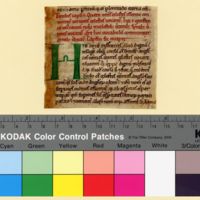
Identifier: Fragmenta Manuscripta 026
Date: 1185-1199
Contents: Hugh of St. Victor, Celestial Hierarchy IX 10, 11, commentary on.
Language: Latin
Location: England, Rochester (?)
Script: Transitional

Identifier: Fragmenta Manuscripta 027
Date: 1100-1199
Contents: Lectionary. Contains part of the office for August ?, Bible, Proverbs vi
Language: Latin
Location: England
Script: Gothic
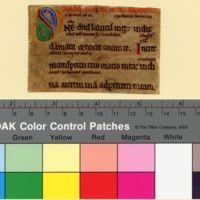
Identifier: Fragmenta Manuscripta 028
Date: 1140-1160
Contents: Psalter, glossed
Language: Latin
Location: England
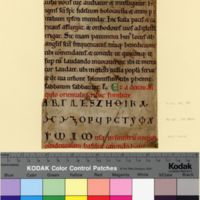
Identifier: Fragmenta Manuscripta 034
Date: 1100-1199
Contents: Pontifical. Dedication of a church with numerals, written as Greek letters, some of which were dropped from the Ionic ABCs in s. XI
Language: Latin, Greek
Location: England
Script: Gothic
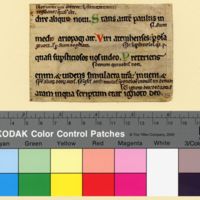
Identifier: Fragmenta Manuscripta 035
Date: 1185-1199
Contents: Bible, glossed. Contains Acts with gloss
Language: Latin
Location: England
Script: Gothic
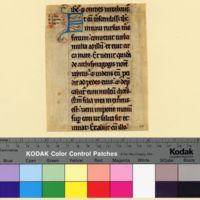
Identifier: Fragmenta Manuscripta 036
Date: 1190-1210
Contents: Bible. Contains section from the gospel of Mark, chapter 5.
Language: Latin
Location: England
Script: Gothic
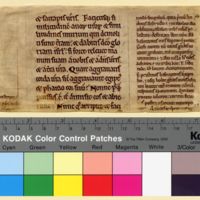
Identifier: Fragmenta Manuscripta 037
Date: 1185-1199
Contents: Bible, glossed. Contains I Samuel 6 and commentary
Language: Latin
Location: England
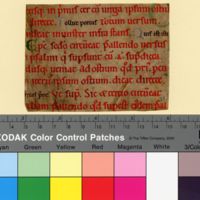
Identifier: Fragmenta Manuscripta 038
Date: 1100-1199
Contents: Pontifical. Contains part of the service for the dedication of a church. See London, BL Add 28188 (Ramsey ?) and CCC 44 (Canterbury)
Language: Latin
Location: England
Script: Gothic
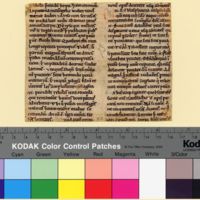
Identifier: Fragmenta Manuscripta 042
Date: 1190-1210
Contents: Homily
Language: Latin
Location: England
Early Modern (c. 1350- c. 1850)
One of the major historic and stylistic periods within the Early Modern category is the Renaissance (c. 1350- c. 1600). The dates for the beginning and ending of the Renaissance are arbitrary and vary from region to region. Renaissance means “rebirth,” and the period was so named because of the rebirth of classical ideals. In art, figures resembled classical models in their perfect proportions and naturalism. The text in manuscripts changed once again to resemble more classical forms. The dominant script was Humanistic minuscule, which resembled the Caroline minuscule in terms of the rounded letter forms and the more spacious layout of the words on the page. You can see examples of the Humanistic script, which endured throughout the Early Modern period, and the continuation of cursive hands in the examples below.
This period is also significant for the production of the first printed books in Europe. Johannes Gutenberg invented the printing press around the middle of the fifteenth century. The letterforms (the shapes of the letters) resembled the strokes used in medieval handwritten scripts. The printed book gradually replaced the need for the carefully handwritten and meticulously prepared manuscript—a fact that is well represented by the comparatively smaller number of manuscript fragments from the fifteenth and sixteenth centuries than from earlier periods in Fragmenta Manuscripta.
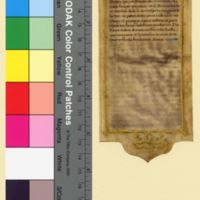
Identifier: Fragmenta Manuscripta 213
Date: 1500-1525
Contents: Book of hours
Language: Latin
Location: France
Script: Humanistic
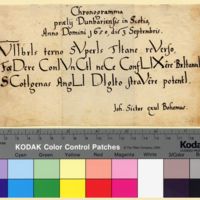
Identifier: Fragmenta Manuscripta 204
Date: 1650-1699
Contents: Chronogram
Language: Latin
Location: Scotland
Script: Humanistic
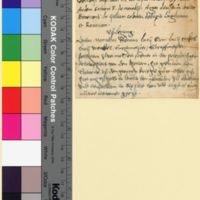
Identifier: Fragmenta Manuscripta 205
Date: 1600-1699
Contents: Notes
Language: Latin, German
Location: Germany
Script: Cursive
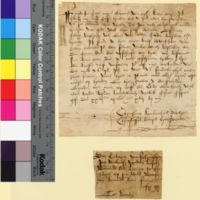
Identifier: Fragmenta Manuscripta 206
Date: 1640-1660
Contents: Letter
Language: German
Location: Germany
Script: Cursive
NOTES
[1] Helmut Gneuss and Michael Lapids (eds), Anglo-Saxon Manuscripts: A Bibliographical Handlist of Manuscripts and Manuscript Fragments Written or Owned in England up to 1100 (Temple, AZ: Arizona Center for Medieval and Renaissance Studies, 2001), for Indiana University, Lilly Library, Bloomington (796.3, 796.6), for Newberry Library, Chicago (808.7), for University of Missouri, Ellis Library, Columbia (809.8, 809.9, 810, 811), for The Scriptorium, Grand Haven, Michigan (829.8), for University of Kansas, Kenneth Spencer Research Library, Lawrence (117, 639, 436), for J. Paul Getty Museum, Los Angeles (817), for Yale University, Beinecke Library, New Haven (157, 857, 831.2, 858, 859, 146), for Pierpont Morgan Library, New York (860-866), for Public Library, New York (866.5), for Free Library, Philadelphia (857), for Princeton University Library (905), for Huntington Library, San Marino (934, 818.5), for University of Illinois Library, Urbana (938), for Folger Shakespeare Library, Washington DC (943.2). And for more on Anglo-Saxon manuscripts see Elzbieta Temple, Anglo-Saxon Manuscripts, 900-1066, Volume 3 (London: Harvey Miller, 1976).
[2] For more on the development of this script, see the history of the Bible.
BIBLIOGRAPHY
Brown, Michelle P. A Guide to Western Historical Scripts: From Antiquity to 1600. Toronto:University of Toronto Press, 1990.
de Hamel, Christopher. Making Medieval Manuscripts. Oxford: Bodleian Library, University of Oxford, 2018.
“Handwriting Styles.” University of Nottingham, Manuscripts and Special Collections. Last Accessed October 20, 2020, https://www.nottingham.ac.uk/manuscriptsandspecialcollections/researchguidance/medievaldocuments/handwritingstyles.aspx.
Smith, Marc H. and Laura Light. Script, Primer 9. New York: Les Enluminures, 2015.
Temple, Elbieta. Anglo-Saxon Manuscripts, 900-1066. London: Harvey Miller, 1976.
